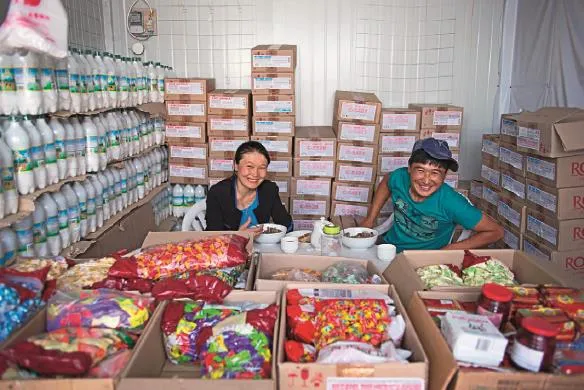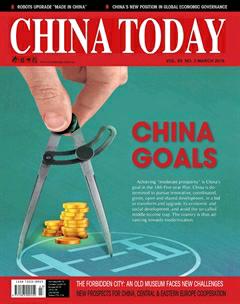Creating Chinese Value along the “Belt and Road”
By YOU SHANSHAN
Creating Chinese Value along the “Belt and Road”
By YOU SHANSHAN
ON June 1, 2015, the Yalian
Market in Almaty, Kazakhstan, was abuzz with business as usual. Huang Jie, who runs a 2,000-square-meter food and kitchen supply store there, was wrangling with a customer. After slashing KZT 3,000 off the initial offer, she clinched the wholesale deal in a minute.
Among the first tenants in the market, Ms. Huang has built up a steady clientele. The 51-year-old has been doing business in Kazakhstan for nearly 20 years. A retired skater formerly on the Xinjiang regional team, she discerned the business opportunities there during a two-year training program in that country. “The Kazakhs are hospitable to the Chinese. After Kazakhstan suffered a dire shortage of commodities in the wake of the collapse of the Soviet Union, light industrial products from China sold like hot cakes.” After some 20 years Huang Jie has built a successful business in Kazakhstan, with daily turnover at her Yalian store reaching RMB 300,000-400,000.

Huang Jie’s thriving store at the Yalian Market in Almaty, Kazakhstan. Zou Hong
“All my stock is from China.” This is evident from the labels of the products on display, which are all in Chinese.“Almost all the things sold in this market are from Yiwu, in China’s Zhejiang Province, and they are sold wholesale. So I make one or two trips to Yiwu every year,” Huang said.
Yiwu is a world-renowned hub for small commodities distribution. On a daily basis, consumer products of myriad types are shipped, by train, oceanliners or airplanes, out from this city to wholesale markets of different sizes all over the world. For Yalian, the prod-ucts from Yiwu are first transported via highway or railway through the Horgos or Alataw customs in Xinjiang on the border with Kazakhstan. After customs clearance they reach the Yalian Market in two days.
In January 2014, the Yiwu-Xinjiang-Europe freight train was launched, taking Chinese products to Almaty. There some are dispatched to neighboring countries like Kyrgyzstan, Turkmenistan and Tajikistan, with the rest heading on to Europe by way of Turkey.
“After all these years Chinese-made commodities have achieved both competitive prices and good quality – at least above-average quality. So the market I’m in has a huge flow of goods, taking in one container daily, or at least two or three a week in the slow season,”Huang said. “Since the opening of the Yiwu-Xinjiang-Europe line I’ve noticed that delivery has become faster and the customs procedures simpler.”
This rail route has also facilitated the globetrotting of exports from other Chinese cities. In Chongqing, southwestern China, for instance, a laptop computer from the local HP plant can travel aboard the Yiwu-Xinjiang-Europe train through the Alataw Port and then to certain Central Asian countries, before landing in the hands of a client in Duisburg, Germany. In Xi’an, parts of the heavy trucks produced by the Shaanxi Automobile Group are loaded onto the Chang’an train for the assembly lines in Almaty. From there the completed vehicles then head for Russia and Europe aboard another international freight train or through the cross-border highway linking western China that traverses five states in Kazakhstan.
Entering the Chinese Market
Trade never goes one way.
On May 22, 2015, the 19th Investment and Trade Forum for Cooperation between East and West China as well as the Silk Road International Exposition opened in Xi’an, capital of Shaanxi Province and the largest city in northwest China. Nearly 100,000 businesspeople from 45 countries participated.
In the Kazakhstan section, Posa, a Kazakh girl studying in Xi’an, promoted in fluent Chinese a pumpkin oil made by Cezam Eko, the largest food producer in her country. This was the first time the company had attended the expo and made its first field study of the Chinese market. “With a population of 1.3 billion, China is a huge market for food companies like us. This is our first visit to Xi’an. We hope to find partners in China who will sell our cooking oil across the country. If it sells well, we will consider opening plants in China,” said the general manager of Cezam Eko.
Compared with bigger corporations like Cezam Eko, many smaller businesses are already active. Temur from Kazakhstan, for instance, has opened a food store at the Border Cooperation Center in Xinjiang’s Horgos Port. This center straddling Chinese and Kazakh territory is so far China’s only crossborder trade center – 3.43 square kilometers of it is in China and 1.85 square kilometers in Kazakhstan. Transactions at the center are subject to multiple preferential policies including those on taxation.

Workers at Pengsheng Industrial Park, which is 70 kilometers from Tashkent, capital of Uzbekistan. Zou Hong
After China unveiled the Silk Road Economic Belt Initiative, it was warmly received by the Kazakh government, who initiated the Horgos-East Gate Special Economic Zone. Last year Kazakhstan allocated KZT 12.5 billion (US $67.3 million) to infrastructure construction in this zone, which is scheduled for completion this year. This project is expected to increase the cargo volume passing through the Horgos Port sevenfold, reaching four million tons annually. What is more, it is forecast to draw KZT 150 billion in investment into Kazakhstan, creating nearly 20,000 jobs for its people.
Temur set up his store in the Kazakh section of the center at the very beginning of its operation. He sells confections and drinks from his country, which, being all “green” foods, are popular among Chinese buyers. Now the 10-square-meter shop enjoys a handsome daily turnover of RMB 100,000.
This shrewd businessman follows the development of the Silk Road Economic Belt closely, discerning lavish business opportunities in it. “I’m glad that our countries share the desire to increase trade and to revive the Silk Road in this new century. Every one of us will benefit from this,” Temur said.
What China Offers to “Belt and Road” Countries
Light industrial goods are only part of what China exports to regions along the“Belt and Road.” At the Shanghai Cooperation Organization Summit in June 2006, China’s TBEA signed an agreement with Tajikistan’s Ministry of Electricity to build 220 KV to 500 KV highvoltage transmission lines for the Tajik power grid. Three years later the project was completed.
In 2010 the Tashkent division of Huawei opened the first 4G network in Uzbekistan. Huawei established an office in the country in 1999, and a subsidiary in 2005. It is now the largest telecomequipment supplier in Uzbekistan.

Temur from Kazakhstan opened a food store at the Border Cooperation Center in Xinjiang’s Horgos Port. Wan Quan
In January 2014, the China Railway Construction Corporation Limited (CRCC) completed the major infrastructure for the second phase of the high-speed railway between Ankara and Istanbul, which is 158-km long, with a contracted investment of US $1.27 billion. This inaugural high-speed rail route built by Chinese enterprises abroad is of seminal significance.
Since agreement was reached on production-capacity cooperation in late 2014, China and Kazakhstan have made noticeable headway in this regard. Last December, Chinese Premier Li Keqiang met with visiting Kazakh counterpart Karim Masimov, and discussed production-capacity cooperation between the two countries, among other issues. Later, Gui Congyou, director general of the Ministry of Foreign Affairs’ Department of European-Central Asian Affairs, announced at a press conference: “The past year has seen fruitful cooperation on production capacity between China and Kazakhstan. Agreements on 52 projects have been clinched, with a total value of US $24.1 billion. They cover various industries including iron and steel, cement, panel glass, and automobiles. So far, car-making and PPE projects have begun construction, and the Astana light rail will kick off in 2015.”
Some Chinese manufacturers have relocated plants to countries along the“Belt and Road.” The Pengsheng Industrial Park, funded by the private Chinese company Jinsheng of Wenzhou City, is a three-hour drive from Tashkent, capital of Uzbekistan, where industry is still less developed. With seven plants at present churning out ceramic tiles, footwear, mobile phones, etc., it achieved an output of US $56 million in 2013, and paid taxes of US $5 million to the Uzbek government.
“The Uzbek government offers us generous support, exempting plants from eight types of taxes including property tax, value-added tax and tariffs,” the park’s general manager Wang Xinghe said.
The industrial park exports semiprocessed materials to China, where they are further processed to make finished products for export to Japan and Europe. A by-line extends to the park, hauling its products onto other railways across Central Asia that will take them to China or Europe.
It is anticipated that in the foreseeable future more outsourced Chinese products will flow along the Silk Road, enriching the markets in countries along the way, and also bringing Chinese technology and capital.
YOU SHANSHAN is a reporter with China Pictorial.

